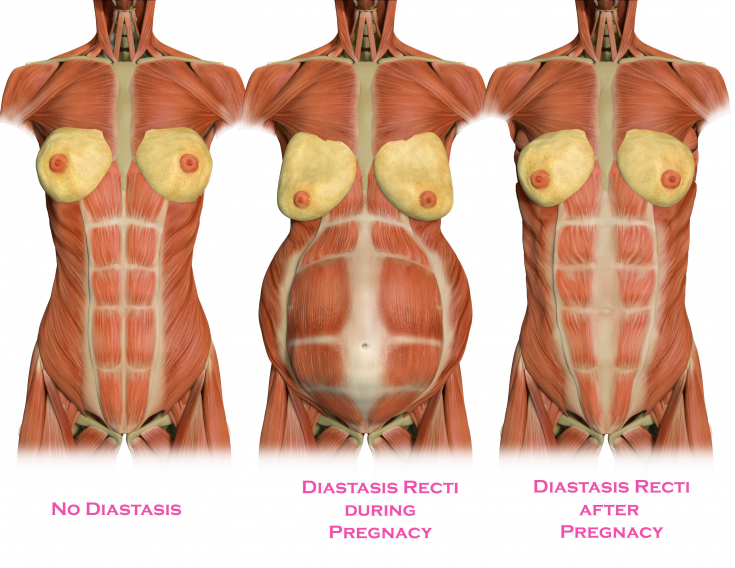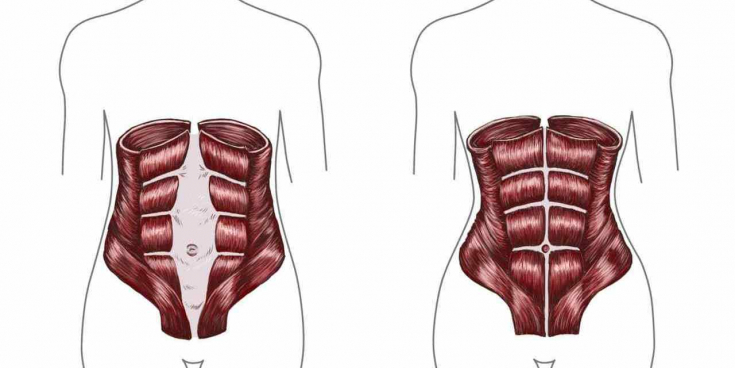Often, women discover diastasis after a few weeks after childbirth. Despite the fact that a lot of time has passed since the birth of the baby, the mother's stomach still remains bulging. At the same time, neither proper nutrition nor regular physical activity helps to cope with this problem.
Diastasis after childbirth – a fairly common occurrence, and in order to eliminate this problem, you should know what exercises you need to perform in order to get rid of diastasis.
Normally, the rectus abdominis muscles should fit snugly enough to each other and be connected to each other by a tendon. With diastasis, these muscles diverge along the midline and the gap between them can be from 2-3 cm to 10-15 cm.
Causes of diastasis
The main provocateurs of diastasis in women are pregnancy and childbirth, and the risk increases if a woman gives birth often. As the fetus grows, it begins to put pressure on the anterior abdominal wall, because of this, divergence and overstretching of its muscles occur. In addition, the body of a pregnant woman produces the hormone relaxin, which softens the tendon of the abdomen, making it sufficiently elastic.

After childbirth, the mother's belly should return to the way it was before, but this is not always the case. Mothers who had a very large belly during gestation are at risk of developing diastasis after childbirth – with multiple pregnancy, polyhydramnios, or if the fetus is very large, the muscles stretch much more than normal. If the expectant mother before pregnancy did not encounter problems with excess weight and devoted time to exercises to strengthen the abdominal muscles both before and after gestation, she does not face such a problem.
Is diastasis dangerous
Often this problem is only aesthetic in nature – the newly-made mother is trying her best to get rid of the resulting tummy, but all efforts are in vain. However, it happens that diastasis is the cause of discomfort, and sometimes the cause of serious health problems. So, there may be pain in the lower back and in the abdomen, which can intensify after lifting weights or prolonged physical exertion.

The most dangerous is diastasis of the third degree, when there is a divergence of muscles by 10 cm or more – the abdominal muscles weaken, the risk of hernias and prolapse of the internal organs increases.
How to detect diastasis
- Lie on your back and bend your knees;
- fingertips should be placed on the midline of the abdomen 3-5 cm above and below the navel;
- muscles of the abdomen should be kept relaxed, the head raised off the floor;
- if you feel a divergence of the abdominal muscles – this indicates diastasis.
Precautions for diastasis
With diastasis after childbirth, everything that leads to an increase in intra-abdominal pressure should be avoided. You need to learn how to lift weights and carry your baby properly and watch how well you get up from a bed or chair and remember to control your cough.
- Coughing, put your palms on the press and lightly press on it. So the stomach will not swell too much.
- Keep your posture correct – you can not slouch and bend in the lower back.
- Do not lift weights that exceed 5-6 kg. When lifting lighter objects, stretch your arms, bending them at the elbows.
- If the baby only calms down in your arms, use it while wearing a postpartum bandage or just wrap your tummy.
- Get out of bed and lie down in it only through the position of lying on your side. At the moment of lifting from a chair, transfer the weight to the left or right buttock, retract the stomach, making a semicircle of the body to the left (or right) side. You should get up mainly due to the strength of your legs.
- Forget about sleeping on your stomach, because in this position there is an increase in pressure on the tendon and anterior abdominal muscles, due to which they are even more stretched.
Read also: "How to lose belly fat"
Exercise for diastasis
Particular attention during exercises with diastasis should be given to breathing, it is contraindicated to strongly inflate the stomach when inhaling. If you have been diagnosed with the second degree of diastasis and you have not been engaged in strengthening the muscles of the press before pregnancy, it is better to use a bandage during classes. Each of the exercises is repeated 10-15 times.
Exercise #1. Compression.
Lie on the floor and bend your knees. Under the lower back, you need to stretch the towel and take it by the ends, then cross your arms slightly bent at the elbows. As you exhale, lift your head and shoulders, while squeezing your waist tightly with a towel, then return to the starting position.
Exercise #2. "Hundred"
The starting position should be the same as in the first exercise. As you exhale, you need to raise your arms, head and shoulders off the floor and linger in this position for a few seconds.
Exercise #3. Leg curl
In order to perform this exercise with diastasis, you should lie on the floor and stretch your arms along the body. In this case, the lower back should be pressed to the floor. Start alternately bending and straightening your legs, while the feet should slide on the floor.
Exercise #4. Shoulder Bridge
You need to lie on your back and stretch your arms along the body. The legs should be bent at the knees, and the feet should be slightly wider than the hips. As you exhale, lift your pelvis up, and as you inhale, lower it.
Exercise #5. "Cat"
Get on all fours, straighten your back, put your hands at shoulder level. After that, the stomach must be pulled in as you exhale, while rounding the back. Return to the starting position while inhaling, repeat the exercise 10-15 times.
Provided that such exercises are performed regularly, it is possible to get rid of diastasis after childbirth in 6-10 weeks. However, third-degree diastasis may require surgery.
Source estet-portal.com






Add a comment